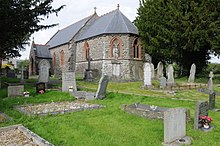Type a search term to find related articles by LIMS subject matter experts gathered from the most trusted and dynamic collaboration tools in the laboratory informatics industry.
Llanyre
| |
|---|---|
Location within Powys | |
| Population | 1,141 (2011)[1] |
| OS grid reference | SO045625 |
| Principal area | |
| Preserved county | |
| Country | Wales |
| Sovereign state | United Kingdom |
| Post town | Llandrindrod Wells |
| Postcode district | LD1 |
| Dialling code | 01597 |
| Police | Dyfed-Powys |
| Fire | Mid and West Wales |
| Ambulance | Welsh |
| UK Parliament | |
| Senedd Cymru – Welsh Parliament | |
Llanyre (Welsh: Llanllŷr or Llanllŷr-yn-Rhos ) is a village and electoral ward in Radnorshire, Powys, Wales. The community had a population of 1,061 in 2001,[2] increasing to 1,141 at the 2011 Census. It includes the village of Newbridge-on-Wye.
Llanyre is to the west of Llandrindod Wells, in the upper Wye Valley. The area is largely rural.
Housing in Llanyre comprises an eclectic mix of nineteenth century stone and brick housing, with newer, more modern housing schemes currently under development.[3]
Local administration is undertaken by the Llanyre Community Council, which is divided into two community wards, Newbridge with six members and Llanyre/Llanfihangel with five. It was previously divided into three community wards, consisting of 12 elected members, as such:
Meetings are held every third Tuesday in the month, excluding August.[4]
Llanyre was a county electoral ward until 2022. The electorate of Llanyre ward was 940 in 2005.[5] Following a boundary review, the Llanyre county ward was substantially added to, with three neighbouring communities (Abbey Cwmhir, Nantmel and St Harmon) being added, and it was renamed Llanyre and Nantmel as a consequence. Newbridge was combined with Disserth and Trecoed community to form the Disserth and Trecoed with Newbridge county ward. The changes were effective from the 2022 local elections.[6]

The Church of St Llyr lies to the south of the village, on the west of the A4081 road to Rhayader. Rebuilt entirely from 1885 to 1887,[7] little remains of the original church apart from the very front of the building. The churchyard contains one war grave, of a Royal Flying Corps officer of World War I.[8]
It is a grade II* listed building.[9]